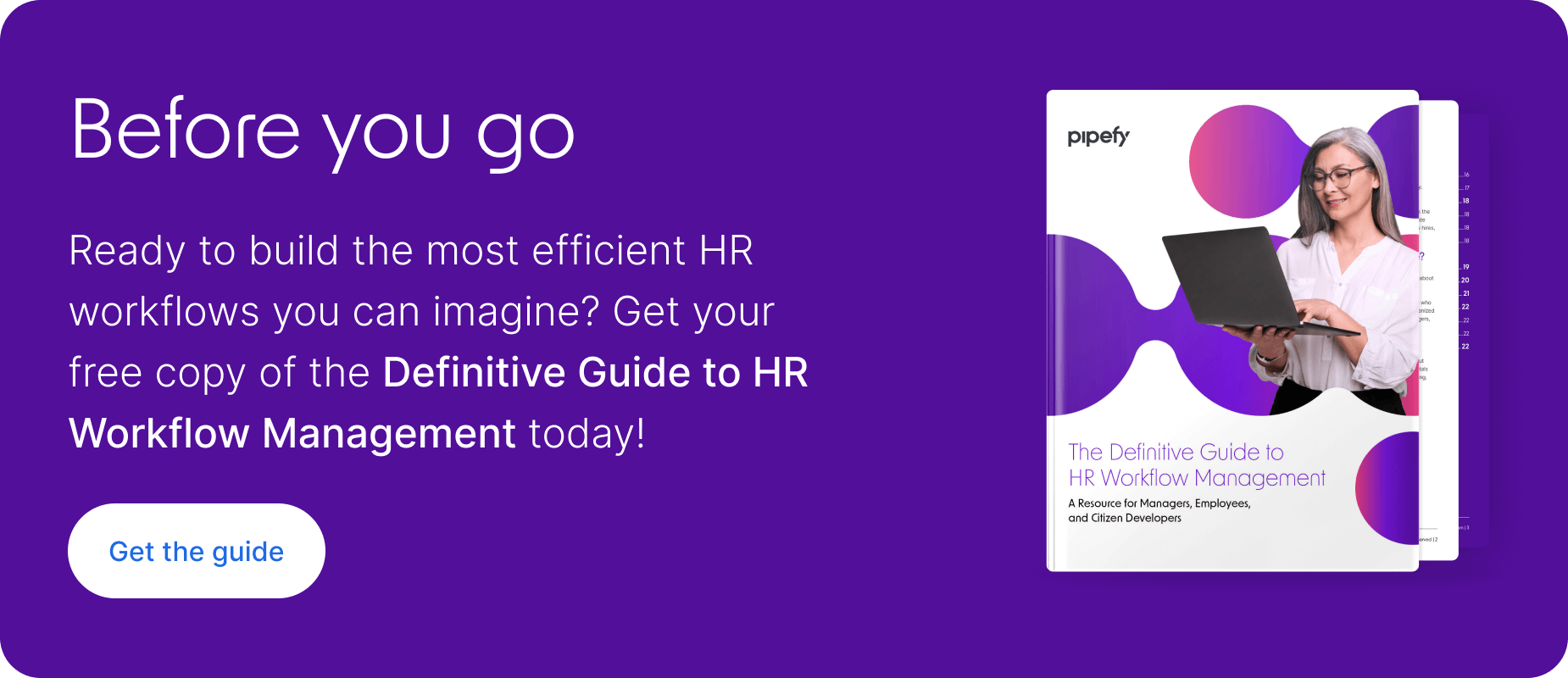
What is an employee performance review?
A performance review is a formal assessment of an employee’s work performance during a certain period of time. The performance review cycle provides an opportunity for managers to highlight the strengths and weaknesses of their employees, and provide constructive feedback to help them develop. The key elements of an employee performance review include a peer or manager providing feedback, the frequency of reviews, and the focus of the review.
During a performance review, managers typically hold a 1:1 conversation with employees to discuss their team impact, goals, and how they’ve developed since their last review. Employee performance reviews often highlight how employees communicate, problem-solve, collaborate, and meet quality and reliability standards.
Definitive Guide to HR WorkflowsDownload now
Examples of performance review
Self-assessment
This aspect of performance evaluation gives employees an opportunity to self-assess their strengths and weaknesses, and outline how they plan to improve their performance. This type of evaluation encourages employee accountability.
360 feedback
As the name implies, this method of evaluation takes into account feedback from an employee’s internal network, like managers, peers, customers, and direct reports for a multidimensional understanding of their performance.
Upward feedback
The upward feedback method lets employees evaluate their managers, which creates a loop of ongoing and mutually beneficial dialogue between managers and employees.
What is the importance of performance reviews?
Performance reviews are important because they provide a framework for employees to grow and develop professionally within their role and the organization, in addition to providing managers a running record of an employee’s work performance history.
Performance reviews inform wider company performance management initiatives, such as strategic planning, compensation reviews, and investments in employee development and technology.
Types of employee evaluation
When conducting performance reviews, timeframes will vary depending on company goals or employee needs. They can occur weekly, monthly, quarterly, or annually.
Weekly reviews
Weekly reviews are great for tracking agile projects with quick turnaround times, providing high-level status updates, or conducting weekly (or biweekly) check-ins to discuss work updates or bottlenecks.
Weekly reviews are not ideal for evaluating employee performances that are goal-oriented or require a vast amount of historical data.
Monthly reviews
Monthly reviews are ideal for following up on short-term projects or tasks — like working with freelancers, transitioning into a new role, or onboarding new employees — and are more thorough than weekly reviews since there is more data to pull from due to the duration between reviews.
Quarterly reviews
Quarterly reviews occur every three months, providing four reviews per year. Quarterly reviews are usually used to track department targets, employee goals, or company budgets, and are great for setting large goals because it provides employees with enough time to work toward achieving them.
In addition to setting and following up on goals on a quarterly basis, it’s common for managers to conduct monthly reviews to assess how well quarterly goals are coming along.
Semi-annual
This type of review happens every six months. This form of employee performance review is ideal for tracking an employee’s progress toward big goals, such as a promotion or a salary increase since it provides six months of data to reflect on.
Annual reviews
Annual reviews happen just once every year, and they take into consideration an employee’s performance throughout the year. Annual reviews were once the traditional form of employee reviews, but they’ve gone out of style due to the large gap in feedback between reviews.
While some companies may still conduct large annual reviews to inform promotions or salary increases, this sort of performance review is typically supplemented by semi-annual, quarterly, monthly, or weekly reviews.
5 areas of improvement that come up in performance reviews
1. Communication
- Does the employee communicate needs, ideas, and successes in an appropriate or timely manner?
- Is the employee respectful and clear in their communication skills?
2. Collaboration
- Does the employee delegate, or work with each other and with other departments effectively?
- Does the employee make effective use of the team’s collaboration tools?
3. Time management
- How well does the employee meet deadlines, work toward team/company goals, or manage day-to-day productivity?
4. Attitude
- Does the employee lead with a positive, encouraging attitude?
- Does the employee encourage teammates and deliver constructive feedback on projects or goals?
5. Knowledge and skills
- Does the employee demonstrate the knowledge or technical expertise required to fulfill their responsibilities?
- Is the employee knowledgeable?
- Do they possess the skills needed to function in their role?
- Is the employee actively seeking ways to improve this area or upskill?
What are the key elements of a great performance review?
In order for employees to understand how they can improve and reach their goals, it’s important to include key elements of a great performance review to ensure clarity, direction, and results.
Don’t lose track of key elements with the SMART feedback framework. Provide constructive feedback that is:
| Specific | Feedback and next steps should be clear and logical. |
| Measurable | Always lead with feedback that is verifiable and can be tracked to specific goals. |
| Attainable | Goals that are created during performance reviews should be challenging, but not overwhelming. |
| Relevant | Avoid feedback that doesn’t align with company goals or mission, or that doesn’t have a direct impact on improving performance. |
| Time-bound | Action items have deadlines or time frames for action items to help employees plan and complete these items, and to make it easier to measure progress. |
How to do an employee performance review
Whether you’re a manager or a peer providing feedback, here are some tips for reviewing employee performance:
Designate a time, place, and reason for the review, and communicate it ahead of time.
Whether you’re a manager meeting with a direct report or an employee reaching out to a coworker, be clear about your intent. Skip the ominous “can we talk?” message, and be upfront with your request. Lay the framework for the review — whether that’s establishing the frequency or focus upfront — and be clear about the review’s goal, purpose, and process.
Learn more about how to build a scalable performance evaluation process.
Listen and speak carefully.
The purpose of employee performance reviews is to help employees develop their skills and to help the business achieve its goals. The best way to achieve both goals is through effective communication. Avoid any negativity during reviews, and listen carefully to what they’re saying so that you can be thoughtful with your responses. Employee reviews can also be opportunities for the management team to learn how to create better employee experiences.
Provide examples.
In order for feedback to be beneficial, it’s important to provide examples or verifiable data regarding their performance. Examples also help you avoid vague or ambiguous feedback that may cause frustration or undermine employee confidence in the review process.
Have an idea of the next steps ready.
Performance reviews should be treated as a collaborative conversation between managers and employees, not a lecture by managers for employees. Be prepared for the employee to ask questions and guidance on how to improve their performance.
Best practices to improve your performance review process
Create clear evaluation standards.
Make sure that you have a clear evaluation standard outlined for every position you are evaluating that can be used and should be used for each individual in that current position. This ensures fairness for every employee and eliminated bias.
Support and check-in with managers.
Hold your managers accountable for routinely evaluating and guiding their employees toward their performance goals. Managers work with employees every day and can give upper management a clearer picture of how that particular employee is doing and what they need to improve.
Encourage employees to upskill.
Another great practice is to make a conscious effort to join individual and company goals. An employee will naturally work harder for the good of themselves than the good of the company, which is not always a bad thing. Having your employees learn new skill sets can help you both in the future. Talk with each employee about what they think they could learn before their next review and make that a goal for the next evaluation.
Change the way you think about performance reviews.
Instead of thinking of them as annual or semiannual events, think of them on a daily basis. Always find a way to make improvements every day instead of a month or so before reviews begin. This will be a less noticeable thing at first, but once you look at the big picture, you can see dramatic improvements which are less fueled by peer pressure and much more intricately put together than a last-minute slap job.
Be transparent about performance reviews.
The last tip we have for you today is to make sure your employees know how they are being graded on their evaluations. Is attendance a big issue? How about their teamwork skills? What percentage of their evaluation is coming from their individual work? Their attitude? Knowing just how the scales are tipped can help your employees work on the areas of their evaluation that matter most.
Get started with Pipefy’s performance review process template
Evaluating your employees is extremely necessary within companies. Without performance evaluations, employees don’t know what their strengths are and what behaviors they need to work on.
Start tracking how your employees are doing with Pipefy’s performance evaluation template. With Pipefy, you can easily create and customize an automated review process that cuts out repetitive, manual work for managers so they can focus on helping employees improve their work performance.










